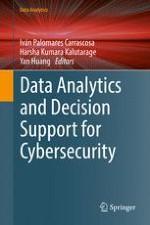The book illustrates the inter-relationship between several data management, analytics and decision support techniques and methods commonly adopted in Cybersecurity-oriented frameworks. The recent advent of Big Data paradigms and the use of data science methods, has resulted in a higher demand for effective data-driven models that support decision-making at a strategic level. This motivates the need for defining novel data analytics and decision support approaches in a myriad of real-life scenarios and problems, with Cybersecurity-related domains being no exception.
This contributed volume comprises nine chapters, written by leading international researchers, covering a compilation of recent advances in Cybersecurity-related applications of data analytics and decision support approaches. In addition to theoretical studies and overviews of existing relevant literature, this book comprises a selection of application-oriented research contributions. The investigations undertaken across these chapters focus on diverse and critical Cybersecurity problems, such as Intrusion Detection, Insider Threats, Insider Threats, Collusion Detection, Run-Time Malware Detection, Intrusion Detection, E-Learning, Online Examinations, Cybersecurity noisy data removal, Secure Smart Power Systems, Security Visualization and Monitoring.
Researchers and professionals alike will find the chapters an essential read for further research on the topic.
